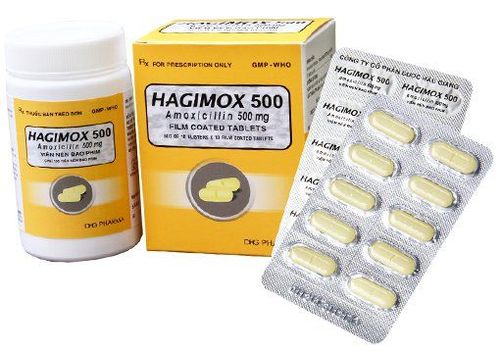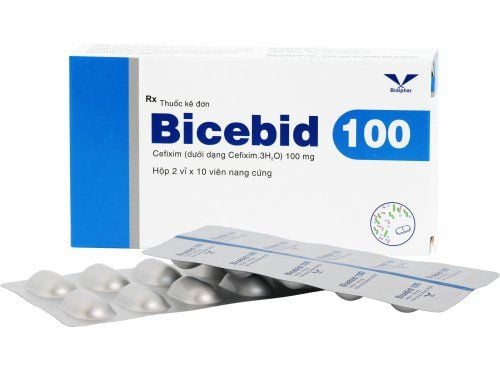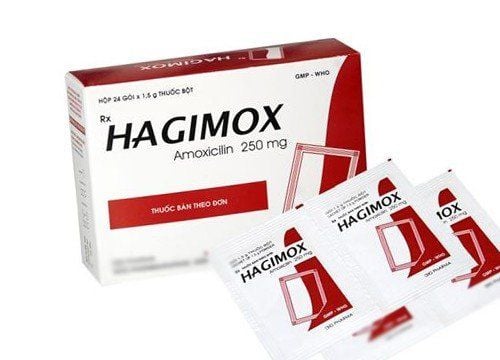This is an automatically translated article.
Hagimox drug has the main ingredient is the antibiotic Amoxicillin. It is indicated for the treatment of bacterial infections including respiratory tract infections, uncomplicated urinary tract infections, skin infections and other infections.
1. What is Hagimox 500mg?
Hagimox 500mg drug has the main active ingredient is the antibiotic Amoxicillin. This is an antibiotic of the aminopenicillin group, with a broad antibacterial spectrum.
Ability to absorb: The antibiotic amoxicillin is stable in the acidic environment of gastric juice. Absorption of the drug is not affected by food, and is more rapidly and completely absorbed from the gastrointestinal tract than ampicillin. Distribution: Amoxicillin is rapidly distributed into most body fluids, with the exception of cerebrospinal fluid and cerebrospinal fluid, but when meningitis occurs, amoxicillin has the ability to diffuse easily. After taking the drug with a dose of 250mg of amoxicillin 1-2 hours, the concentration of amoxicillin in the blood reached about 4-5mcg/ml, when taking 500mg, the concentration of amoxicillin reached 8-10mcg/ml. Elimination: Approximately 60% of an oral dose of amoxicillin is excreted unchanged in the urine over a period of 6 to 8 hours. The half-life of amoxicillin is approximately 1 hour, with a longer duration in neonates and the elderly. In patients with renal impairment, the half-life of amoxicillin is approximately 7-20 hours.
2. What are the effects of Hagimox?
Hagimox drug with active ingredient Amoxicillin is aminopenicillin, stable in acid environment, has a broader spectrum of action than benzylpenicillin, especially effective against gram-negative bacilli. Similar to other penicillins, amoxicillin has a bactericidal effect due to its ability to inhibit the biosynthesis of mucopeptides of the bacterial cell wall.
Amoxicillin is active against most gram-negative and gram-positive bacteria such as: streptococcus, non-penicillinase-producing staphylococci, E.coli, H. influenzae, Diplococcus pneumoniae, N.gonorrhoeae and proteus mirabilis.
Amoxicillin is inactive against penicillinase-producing bacteria such as methicillin-resistant staphylococci, strains of Pseudomonas and most strains of Klebsiella and Enterobacter.
Hagimox is prescribed in the treatment of the following conditions:
Treatment of infections caused by bacteria sensitive to Hagimox in the following locations:
Upper respiratory tract infections (including ENT ) such as: tonsillitis , sinusitis and otitis media ; Lower respiratory tract infections, such as exacerbations of chronic bronchitis, lobar pneumonia and bronchial pneumonia; Gastrointestinal infections: typhoid fever; Urinary tract infections: such as gonorrhea, septic abortion or obstetric infections, pyelonephritis. Infections such as sepsis, meningitis, and endocarditis caused by susceptible bacteria should be treated initially intravenously at high doses and, if possible, in combination with the use of use another antibiotic. Endocarditis Prophylaxis: Amoxicillin can be used to prevent sepsis that can develop into endocarditis.

Hagimox 500mg là thuốc gì? Hagimox là một loại kháng sinh được dùng theo kê đơn
3. Undesirable effects of the drug Hagimox
Adverse effects of Hagimox are uncommon or rare and are mostly mild and temporary in nature.
Hypersensitivity reactions: Skin rash, itching, urticaria; erythema multiforme and Stevens-Johnson syndrome; toxic epidermal necrolysis, bullous-exfoliative dermatitis and acute exacerbation of systemic pustulosis (AGEP). If any of the above reactions occurs, treatment with Hagimox should not be continued. Gastrointestinal reactions: Nausea, vomiting and diarrhea; intestinal candidiasis; colitis during antibiotic therapy (including hemorrhagic colitis and pseudomembranous colitis). Effects on the liver: Hepatitis and cholestatic jaundice. Effects on the kidneys: Crystalluria. Hematological effects: Transient leukopenia, transient thrombocytopenia and hemolytic anemia; prolongs bleeding time and prothrombin time. Effects on the central nervous system: Dizziness, hyperactivity and convulsions. Convulsions may occur in people with kidney failure or those taking high doses of Hagimox. This is not a complete list of the possible side effects of Hagimox and some may experience other side effects. If you have any questions or experience any side effects, consult your treating doctor or pharmacist.
4. How to use and dose Hagimox
Hagimox is used orally, you can take it before or after eating without affecting the effect of the drug. The interval between dosing can be 8 hours (three times a day) or 12 hours (two times a day).
Note, when treating with Hagimox film-coated tablets, you need to swallow the tablet whole with water, do not chew or crush the drug to avoid losing the effect of the drug. As for the suspension form, you can give it to your child to drink directly or add it to milk, drinks and use it immediately.
How to use orally.
The usual therapeutic dose is 250 - 500 mg, every 8 hours. Children under 10 years old can take 125-250mg dose, every 8 hours. Children weighing less than 20kg, usually use the drug at the following dose of 20-40 mg/kg body weight/day. Dose of 3g, repeated after 8 hours to treat periodontal abscess, or repeated after 10-12 hours for the treatment of acute urinary tract infections uncomplicated. Prophylactic dose of endocarditis in susceptible individuals, given as a single dose of 3g approximately 1 hour before procedures such as tooth extraction. Use a high-dose regimen of 3g x 2 times/day for people with severe or recurrent respiratory infections. If needed, children 3 to 10 years old with otitis media can be given 750mg twice daily for 2 days. For patients with renal failure, the therapeutic dose must be reduced according to the creatinine clearance:
Cl creatinine < 10 ml/min: use Hagimox 500 mg/24 hours. Cl creatinine > 10 ml/min: take Hagimox 500 mg/12 hours. How long to take Hagimox will vary from person to person, depending on the type of infection you have. However, you need to make sure to take the full dose until the end of the prescribed course, even if your symptoms have improved.
If you stop treatment with Hagimox too soon or take not enough doses, the infection may not be completely cured, it may recur and create conditions for bacteria to become resistant to antibiotics.

Thuốc Hagimox có tác dụng gì? Hagimox có tác dụng điều trị nhiễm khuẩn
4. Hagimox drug interactions
Hagimox may change the ability of medicines you are taking or increase the effects of unwanted effects on your body. To minimize possible drug interactions, it is best to write a list of all the medications you are taking (including prescription, nonprescription, herbal and dietary supplements). ) then show it to the treating doctor. In addition, to ensure safety when taking medicine, you should not self-medicate, stop using or change the dosage of the drug without the permission of your doctor.
Some drugs you are using can interact with Hagimox that you need to be aware of, including:
Other antibiotics. Anticoagulants such as warfarin; Oral contraceptives; Probenecid; Allopurinol; Nifedipine; Methotrexate.
6. Note when using Hagimox medicine
Hagimox is contraindicated in the following cases:
In cases of hypersensitivity to Penicillins and Cephalosporins. Patients with infectious mononucleosis. People who are being treated with the drug Allopurinol. In case of long-term treatment with Hagimox, it is necessary to periodically check liver function, kidney function and blood count during the course of drug use.
Long-term use of Hagimox antibiotic may increase the risk of fungal infections, non-susceptible bacteria or the risk of diarrhea, colitis caused by Clostridium difficile bacteria.
Stop taking the medicine and call 911 or go to the nearest hospital right away if you have a serious allergic reaction such as erythema, Stevens-Johnson syndrome, anaphylaxis, or if you have bloody diarrhea. Do not self-medicate with anti-diarrheal drugs unless directed by your doctor.
Hagimox is a medication that reduces the effectiveness of oral contraceptives you are taking, you may be advised to use another method (such as condoms, film, spermicide) to prevent pregnancy while using this medicine.
Hagimox is a broad spectrum antibiotic that is effective in the treatment of bacterial infections. To ensure effective use and avoid unwanted side effects, you should carefully read the instructions or strictly follow the instructions of the treating doctor.
Please dial HOTLINE for more information or register for an appointment HERE. Download MyVinmec app to make appointments faster and to manage your bookings easily.













